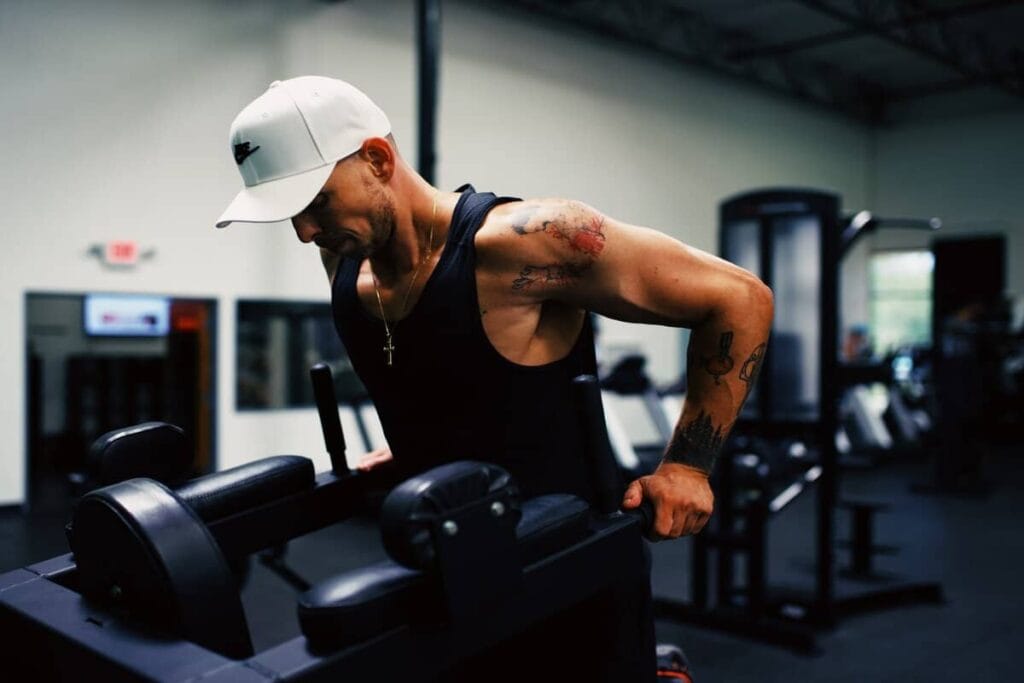I’ve rounded up the ten best exercises for those who want to improve their fitness and physical appearance by sticking to a few exercises and doing them every day for a few weeks or months.
Doing the same exercises daily can be boring. However, I’ll share those exercises that target every muscle and will help you stay fit, active, and strong.
Here’s a quick list of exercises you can do every day at home and gym.
- Push-up
- Squat
- Bench Dip
- Lunges
- Plank
- Pull-up
- Inverted Row
- Burpee
- Bar Dip
- Floor IYT Raises
If you’re a beginner, you can do the first five exercises daily at home. The next five are for intermediates.
Besides these exercises, you can also do warm-up exercises, such as mountain climbing, squat jumping, and jumping jacks, every day.
Moreover, you can perform different stretching/yoga poses for better mobility and flexibility along with these standard muscle-building bodyweight exercises.
10 Best Exercises You Can Do Everyday
1. Pushups

The pushup works on multiple muscle groups simultaneously, such as the chest, triceps, core, and anterior deltoid.
It helps improve fundamental strength, build muscle mass, and scale you up for compound liftings, such as bench presses and military presses.
There are various types of pushups, such as diamond, incline, wider, archer, and pike. However, they are challenging for beginners.
I’ve written a separate article on beginner pushups, which you can check out.
How to perform a standard push-up:
- Place your hands on the floor so your arms are straight underneath your shoulders.
- Get into a high plank position with your hands and toes on the ground. Your body will form a straight line from head to heels. Brace your abdominal muscles. That’s the start.
- Bending your elbows, take your chest toward the floor as low as possible.
- Extending your arms, push back to return to the starting position. That’s one rep.
- You can perform as many sets and reps as you like.
Note: You can do different pushup variations on different days for better strength, balance, and muscle gain. Additionally, you can perform weighted pushups a couple of days weekly to maximize strength and muscle growth.
2. Bodyweight Squat

The squat is a lower-body exercise that hits several muscles simultaneously, primarily the quadriceps (a sizable muscle that helps walk, run, and jump efficiently).
Bodyweight squats also help improve body composition, decrease fat percentage, increase muscle gain and muscular strength of the knee extensors, and jump performance in adolescent boys. 1Takai, Yohei et al. “Effects of body mass-based squat training in adolescent boys.” Journal of sports science & medicine vol. 12,1 60-5. 1 Mar. 2013
Squatting has multiple variations, such as the standard, sumo, lateral, and frog squat, and you can do a different one each day.
Steps to perform a standard squat:
- Stand upright with your feet shoulder-width apart and toes pointing slightly out.
- Keep your core tight, chest up, and back straight. That’s the starting point.
- Lowering into a squat position, try to go as far downward as possible or until your thighs are parallel to the floor.
- Pressing through your feet, return to the standing position.
- Maintain a neutral spine position throughout the movement.
You can also do weighted squats with dumbbells, barbells, and kettlebells. However, I don’t recommend doing weighted ones every day as they put more stress on your spine and can be taxing on your knees.
3. Bench Dip

The bench dip is a bodyweight push exercise that helps build size, strength, and power in the triceps and maximizes pressing movements.
Like squats and pushups, you can also perform different dips daily, such as bar, bench, box, floor, and kitchen counter dips.
Steps to perform bench dips:
- Sit on the bench with your arms straight at your sides and feet flat on the ground.
- Keep your arms straight beside your hips, lift your butt off the chair, move your torso forward slightly, and extend your legs in front of you. That’s the starting position.
- Bend your elbows and dip down as low as possible.
- Now, pushing through your hands, extend your elbows until your arms are straight.
4. Lunges

The lunge is a lower body strength and mobility exercise that enhances balance, strength, and functional fitness.
It engages multiple muscle groups simultaneously and improves running, jumping, and squatting performance.
You can do different types of lunges to train your legs from multiple muscles. For instance, forward lunges work more on your quads and reverse lunges activate more hamstrings and glutes.
Steps to perform a forward lunge:
- First, stand upright with your feet together and back straight.
- Take a large step forward with your left leg to stand in the split stance. That’s the start.
- Lower into a lunge until your knees are bent at a 90-degree angle. Make sure your body weight shifts forward onto the leading leg.
- Pushing through your feet, return to the starting position.
5. Plank

Plank is one of the best ab exercises you can do every day. It is an isometric exercise that increases core strength and stability.
A strong core supports your lumbar spine, improves posture, and enhances compound liftings, such as the deadlift, bench press, and squat.
Planking also burns significant calories in a short time and boosts your endurance.
Planks are suitable for all fitness freaks, whether you’re a beginner or pro or want to lose weight or build muscles, you can incorporate plank into your home workout routine.
You can do several types of planks, such as forearm plank, side plank, and extended plank, to optimize your overall performance.
Steps to perform a plank:
- Place your forearms on the floor and extend your legs behind to get into a plank position.
- Slightly raise your hips, brace your core, and stay in an isometric position for as long as you can hold.
Once you improve your strength and fitness, you can also perform weighted planks for better results.
6. Pull-up

The pull-up is a bodyweight pull exercise that simultaneously engages many upper body muscles, especially the back and biceps.
Doing daily pull-ups will help you increase strength and muscle mass, improve your grip strength, and scale your fitness to the next level.
You can use different grips to perform pushups, such as wide and narrow grip pull-ups. The wider grip works more on your lats, while the short grip also hits the biceps efficiently.
Steps to perform a standard pull-up:
- Grip the pull-up bar with an overhead grip, hands a few inches wider than shoulder-width apart.
- Pull yourself up until your chin crosses the bar.
- Pause for a moment and then return to the hanging position.
7. Inverted Row
The inverted row, also known as the Australian pull-up, is another excellent exercise to build muscle, strength, and balance in the upper body muscles, especially the lats, upper back, and hip extensor muscles, without putting much stress on your lower back. 2Fenwick CM, Brown SH, McGill SM. Comparison of different rowing exercises: trunk muscle activation and lumbar spine motion, load, and stiffness. J Strength Cond Res. 2009 Mar;23(2):350-8. doi: 10.1519/JSC.0b013e3181942019. PMID: 19197209.
The inverted row is fairly easier to perform than a standard pull-up because you only need to pull your torso toward the bar during the movement.
Doing this exercise daily will help you improve your pulling strength and torso posture.
The best way to perform an inverted row is using a Smith machine bar or gymnastic rings. However, if you cannot access that equipment, you can try using a dinner table at home.
Steps to perform an inverted row:
- Lie under the table and grip the end with an underhand grip, shoulder-width apart.
- Keep your legs straight before you, and place your feet on a chair with your toes pointing up.
- Pull your torso toward the table until your chest touches it.
8. Burpee

The burpee is a full-body exercise you can do every day. It works on various muscles throughout the body, such as the chest, quads, shoulder, and core, and helps improve strength, muscle mass, and speed.
It is one of the fast and high-intensity exercises that also torches plenty of calories, boosts stamina, and maximizes aerobic and anaerobic performance.
Doing burpees for a couple of minutes pumps your heart, increases blood flow, warms you up, speeds up weight loss, and improves cardiovascular fitness. So, it’s an excellent movement to include in your daily routines.
How to perform a burpee:
- Standing in a shoulder-width squat position, jump in the air.
- Land softly into a squat with your chest up and head in line with your tailbone.
- Place your hands on the floor in front of you with your arms underneath your shoulders and your feet.
- Kick your legs behind so you’re in a high plank position. Next, perform a pushup.
- Once you complete the pushup, reverse the movement to complete your first rep.
9. Bar Dips

Dipping on a parallel bar is more challenging than on a bench, especially for beginners. However, it is also pretty effective in maximizing strength and muscles.
Bar dips target multiple muscles throughout the upper body, especially the triceps and chest, and help build a muscular physique.
How to perform bar dips:
- Grab the handles and hoist yourself off the floor.
- Keep your arms fully straight and slightly lean your torso forward.
- Bend your knees behind towards your buttock and brace your core and thighs. That’s your starting position.
- Bending your elbows, lower your body as low as possible, and press back to return to the starting point. That’s your first rep.
10. Floor IYT Raises
The floor IYT raises is one of the easiest and most effective ways to develop strength and mobility in various muscles throughout the body, such as the lats, traps, deltoids, and lower back.
It is one of the daily exercises you can do at home with no equipment. All you need is some space where you can lay down and mood.
Steps to perform bodyweight IYT raises:
- Lie prone on the floor with your face down.
- Keep your arms straight in front of you with your palms facing each other.
- Raise your arms upward as high as possible. Pause for one second, and lower your arms to the start.
- Next, lift your arms slightly outward, making a Y shape. Pause for a moment and return to the beginning.
- Now, take your arms out to your sides and raise them off the floor as high as possible.
Frequently Asked Questions (FAQs)
Should You Exercise Daily?
Yes, you can work out daily. A medically reviewed article published by Healthline.com suggests that you can work out seven days a week if you’re not pushing yourself too hard or getting obsessive about it. Is It OK to Work Out Every Day? – Medically reviewed by Daniel Bubnis, M.S., NASM-CPT, NASE Level II-CSS, Fitness — Written by Emily Cronkleton – Healthline
Regular exercise provides various health benefits, from physical to mental. For example, an article published on Mayoclinic.com has outlined seven crucial benefits of regular physical activity, including weight management, better health conditions, quality sleep, and a better sex life.
Who Can Train Every Day?
Anyone can work out daily unless they have medical issues or injuries.
How Much Can You Exercise Daily?
The latest US guidelines suggest performing moderate aerobic physical activity for at least 150–300 minutes weekly. One minute of high-intense activity is equal to 2 minutes of moderate training. So, based on this data, you can plan your workout routine.
When is The Best Time to Work Out?
Morning is the best time to work out for those who want to exercise daily to maintain a healthy lifestyle. However, you can exercise at any time of the day when you feel more energetic.
When Should You Stop Exercising Every Day?
You can do multiple exercises every day to keep yourself fit, active, and strong, but sometimes you need to take some rest days, mostly when you feel worn out, your muscles stiff, and uneasy. Alternatively, if you feel sore in a specific muscle, you can skip that and train other muscles.
References
- 1Takai, Yohei et al. “Effects of body mass-based squat training in adolescent boys.” Journal of sports science & medicine vol. 12,1 60-5. 1 Mar. 2013
- 2Fenwick CM, Brown SH, McGill SM. Comparison of different rowing exercises: trunk muscle activation and lumbar spine motion, load, and stiffness. J Strength Cond Res. 2009 Mar;23(2):350-8. doi: 10.1519/JSC.0b013e3181942019. PMID: 19197209.






